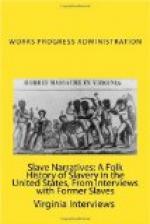“The only thing I can recollect about the War was once my mistress took me and her own little girl upstairs in a kind of ceiling room (attic). They had their ham meat and jewelry locked up in there and other fine stuff. She told us to sit down and not move, not even grunt. Me and Fannie had to be locked up so long. It was dark. We both went to sleep but we was afraid to stir. The Yankees come then but I didn’t get to see them. I didn’t want to be took away by ’em. I was big enough to know that. I heard ’em say we was near ’bout eat out at the closing of the War. I thought it muster been the Yankees from what they was talking about, eating us out.
“I been washing and ironing and still doing it. All my life I been doing that ‘ceptin’ when I worked in the field.
“Me and my daughter is paying on this house (a good house). I been making my own living—hard or easy. I don’t get no relief aid. Never have. I ’plied for the old people’s pension. Don’t get it.”
Interviewer’s Comment
This must be Myers Bogan, yet she told me Bogan Myers. Later she said Dr. Bogan of Forrest City was thus and so.
Interviewer: Miss Irene Robertson
Person interviewed: Fannie Alexander, Helena,
Arkansas
Age: 62
“I was an orphant child. My mother-in-law told me during slavery she was a field hand. One day the overseer was going to whoop one of the women ’bout sompin or other and all the women started with the hoes to him and run him clear out of the field. They would killed him if he hadn’t got out of the way. She said the master hadn’t put a overseer over them for a long time. Some of ’em wouldn’t do their part and he put one of the men on the place over the women. He was a colored foreman. The women worked together and the men worked together in different fields. My mother-in-law was named Alice Drummond. She said they would cut the hoecakes in half and put that in your pan, then pour the beef stew on top. She said on Christmas day they had hot biscuits. They give them flour and things to make biscuit at home on Sundays. When they got through eating they take their plate and say, ’Thank God for what I received.’ She said they had plenty milk. The churns was up high—five gallon churns. Some churns was cedar wood. The children would churn standing on a little stool. It would take two to churn. They would change about and one brushed away the flies. She lived close to Meridian and Canton.
“My mother talked the bright side to her children. She was born in Tennessee. She had two older sisters sold from her. She never seen them no more. They was took to Missouri. Mother was never sold. She was real bright color. She died when I was real little. From what I know I think my parents was industrious. Papa was a shoemaker. He worked on Sunday to make extra money to buy things outside of what his master give them for his family. Now I can remember that much. My papa was a bright color like I am but not near as light as mama. He had a shop when I was little but he wasn’t ’lowed to keep it open on Sunday. I heard him tell about working on Sundays during slavery and how much he made sometimes. He tanned his own leather.




